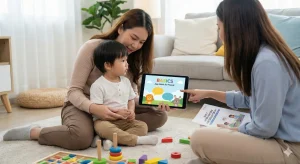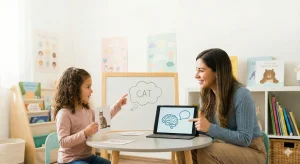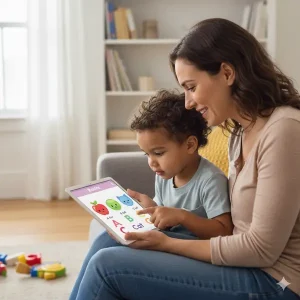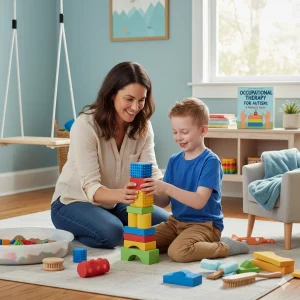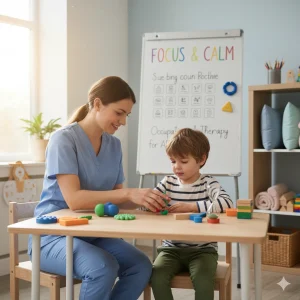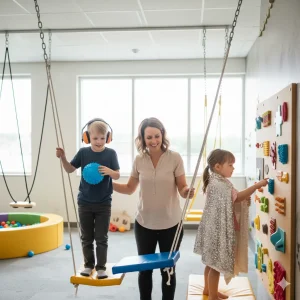Struggling to Write or Dress? Try Occupational Therapy for Kids
By Wellness Hub
Last Updated: October 16, 2025
“Why does my 5-year-old struggle to button a shirt or hold a pencil properly?” — if you’ve ever asked yourself this, you’re not alone. Many parents notice handwriting difficulties or dressing challenges right around kindergarten age. At this stage, fine motor skills like holding a pencil, forming letters, zipping a jacket, or putting on socks are key milestones — and when they don’t come easily, daily routines can turn frustrating for both child and parent. The good news? These struggles aren’t a sign of failure — they’re often a signal that your child may benefit from occupational therapy for 5-year-olds. Through simple, play-based activities and structured strategies, occupational therapy can help your child build hand strength, coordination, and independence in everyday tasks like writing and dressing.
Everyday Struggles That Parents Often Notice
It usually starts with the little things. Your 5-year-old may crumple their worksheet in frustration because their letters don’t look like their classmates’. They might struggle to button their shirt before school, or avoid putting on their jacket altogether. For many parents, these daily struggles are both confusing and concerning.
Statements like —
- “My child hates writing.”
- “They can’t button their shirt on their own.”
- “Handwriting looks messy and uneven.”
- “Getting dressed turns into a daily battle.”
— are more common than you might think. These are not signs of laziness or disinterest; they’re often early indicators of handwriting difficulties in 5-year-olds and challenges with dressing skills that can affect a child’s confidence and independence.
At this age, fine motor skills are still developing. Tasks that seem simple to adults — holding a pencil with control, fastening buttons, or zipping up a jacket — can be genuinely hard for a child who hasn’t yet built the necessary strength, coordination, or motor planning skills. This is where occupational therapy for kids with writing problems can make a meaningful difference.
Through targeted activities, play-based strategies, and gentle support, occupational therapy helps children gain the physical control and confidence they need to succeed in daily routines. Early support not only improves functional skills like writing and dressing but also boosts self-esteem — giving children the chance to feel proud of what they can do.
Why it matters: These everyday struggles are often the first red flags parents notice. Recognizing them early and responding with the right support can set your child up for smoother transitions into school and beyond.
What Writing and Dressing Skills Look Like at Age 5
For most children, age 5 is an exciting time of rapid growth and newfound independence. As they get ready for kindergarten, their fine motor skills become stronger and more coordinated — making it easier to hold a pencil, form letters, and manage everyday self-care tasks like dressing.
When these skills develop on time, children often feel more confident, capable, and ready to learn. But when they lag behind, parents may notice small but significant challenges in handwriting, dressing, or daily routines. Understanding what’s expected at this age can help you identify whether your child simply needs more practice or might benefit from fine motor skills therapy.
Typical developmental milestones at this stage include:
- Mastering pre-writing strokes and using a more controlled pencil grip
- Buttoning, zipping, and putting on socks and shoes with little to no help
- Completing dressing steps in the correct order
- Using their hands together in a coordinated way for writing, drawing, and play
These abilities are more than just physical skills — they’re building blocks for school readiness and self-confidence. When a child can handle these everyday tasks independently, they feel proud and capable, which makes the transition to structured school settings much smoother.
Writing Milestones
By age 5, most children are moving beyond scribbling and starting to develop handwriting readiness. While they may not form perfect letters yet, you’ll notice more control and consistency in their work. Key writing milestones include:
- Drawing and copying basic shapes like circles, squares, and triangles — essential for forming letters later.
- Beginning letter formation, especially capital letters or the letters in their name.
- Controlling pressure and direction, meaning they can guide a pencil on paper with more accuracy and less fatigue.
This is also the stage when handwriting support for kindergarten can make a big difference. Gentle guidance on pencil grip, stroke patterns, and posture helps children avoid frustration and build skills naturally.
Dressing Milestones
At age 5, dressing is more than just putting on clothes — it’s a major self-care skill for kindergarteners. Children should be able to manage most of the routine independently, even if they need a bit of extra time. Typical dressing skills include:
- Putting on clothes with little help, including shirts, pants, and socks.
- Buttoning and zipping independently, with growing confidence in managing small fasteners.
- Knowing dressing sequences, like underwear before pants or socks before shoes — an important part of motor planning and independence.
When children can dress themselves, it doesn’t just save parents time — it gives kids a sense of accomplishment and readiness for school life. If your child is finding these tasks hard, early intervention through fine motor skills therapy can gently strengthen their abilities in a playful, encouraging way.
Bottom line: Writing and dressing milestones at age 5 are important markers of a child’s growing independence. Recognizing where your child shines and where they may need a little extra support is the first step toward helping them thrive.
How Occupational Therapy Supports Skill Development
When everyday activities like writing or getting dressed become daily battles, occupational therapy can be a game changer. Instead of just focusing on the “task,” OTs look at the underlying skills that make these activities easier for your child — like strength, coordination, sensory processing, and motor planning.
At age 5, children are building the foundation for independence. Occupational therapy helps strengthen those foundations through structured routines, hands-on exercises, and play-based strategies designed specifically for young learners.
Key areas of focus include:
- Building hand strength and finger control — Strong, stable hands support better pencil grip and fine motor skills.
- Improving sensory processing and body awareness (proprioception) — Helping kids understand how their bodies move in space to complete tasks smoothly.
- Practicing daily self-care routines in structured steps — Breaking dressing or grooming into manageable parts so children feel successful, not overwhelmed.
- Using play-based activities to build confidence — Turning skill-building into fun so that learning doesn’t feel like work.
OT Interventions for Writing
Writing isn’t just about holding a pencil — it’s about coordination, control, and confidence. Occupational therapists use developmentally appropriate interventions to help children master pre-writing and handwriting skills. Common techniques include:
- Tripod grasp training and in-hand manipulation to strengthen finger control and promote efficient pencil use.
- Slant boards, pencil grips, and multisensory writing to support proper posture, reduce fatigue, and make writing more engaging.
- Visual-motor integration activities to help the eyes and hands work together — an essential skill for writing on lines, copying from the board, and spacing letters.
These approaches build handwriting fluency step by step, reducing frustration and increasing classroom readiness.
Know more: 15 OT-Approved Home Activities to Improve Pencil Grip
OT Interventions for Dressing
Dressing may seem simple, but it requires bilateral coordination, sequencing, and motor planning. Occupational therapy helps children build these skills through structured, supportive strategies such as:
- Task breakdown using forward or backward chaining, where each step of dressing is taught systematically so the child can learn at their own pace.
- Adaptive clothing and visual routines to make dressing less stressful and more achievable for kids who struggle with fasteners or sequencing.
- Fine motor play targeting buttons and zips, like button boards or dressing dolls, to build confidence and hand strength in a fun, low-pressure way.
These small, consistent interventions help children become more independent — a huge confidence booster for both home and school settings.
Why this matters: When children get the right support early on, they don’t just improve their skills — they build confidence, independence, and joy in doing things for themselves. Occupational therapy uses evidence-based strategies like tripod grasp training, proprioceptive input, bilateral coordination, and visual-motor integration activities to set the stage for success in writing, dressing, and beyond.
OT-Backed Activities You Can Try at Home
You don’t need to be an occupational therapist to help your child build essential daily living skills. With just a few minutes a day and the right kind of play-based activities, you can make a big difference in your child’s handwriting, dressing skills, and overall confidence. These simple, OT-backed activities are fun, easy to set up, and perfect for home routines.
By turning skill-building into play, children feel motivated, not pressured, and parents can reinforce what they’re learning in therapy or at school. This daily practice also helps build consistency — a key factor in skill development for 5-year-olds.
Strengthening Fine Motor Skills Through Play
- Playdough and putty games: Encourage your child to pinch, roll, squeeze, and flatten playdough. This builds hand strength and finger dexterity needed for proper pencil grip.
- Clothespins and lacing: Pinching clothespins strengthens small hand muscles, while lacing cards improve bilateral coordination — both essential for writing and dressing.
- Tweezers and small objects: Picking up beads or pom-poms with tweezers refines precision and control.
These fine motor activities for kindergarten writing are easy to fit into daily routines — even just 10 minutes a day can make a noticeable difference.
Sensory Warm-Up Before Writing
Many children write better when their bodies are calm and ready. A short sensory warm-up before writing can help regulate attention, improve focus, and prepare the hands for fine motor work. Simple activities include:
- Wall pushes or chair push-ups
- Squeezing a stress ball or putty
- Heavy work like pushing a laundry basket
This prepares the nervous system for better handwriting control and reduces fatigue during writing sessions.
Buttoning and Zipping Practice on Dolls
Buttoning and zipper practice doesn’t have to be stressful. Instead of rushing during morning routines, try:
- Practicing on dolls or dressing boards
- Using larger buttons or zippers first and working down to smaller fasteners
- Making it playful with pretend “getting ready” games
These low-pressure practice sessions help build confidence and independence over time.
Visual Schedules for Dressing Independence
For many kids, sequencing is just as important as skill. Visual schedules — using pictures or simple step charts — help children remember the order of dressing tasks.
- Example: underwear → pants → shirt → socks → shoes
- Post the chart near the child’s dressing area
- Gradually fade out prompts as they gain independence
This approach supports motor planning and boosts your child’s ability to complete routines on their own.
Recommended Tools for Home Use
You don’t need fancy equipment to build strong skills at home. A few OT-recommended tools can make activities more effective and fun:
- Pencil grips and thick pencils to encourage proper tripod grasp and reduce hand fatigue.
- Button boards and zipper frames for structured fastener practice.
- Sensory putty, tweezers, and tongs to develop fine motor control and grip strength.
Why it matters: A short, consistent daily OT routine for handwriting and self-care tasks can make a huge impact. When parents integrate playful skill-building into everyday life, children develop stronger hands, better motor planning, and more independence — without it feeling like work.
How Schools and Parents Can Work Together
When it comes to helping children succeed with daily skills like handwriting and dressing, the best progress often happens when schools and parents work as a team. Consistent support at home and in the classroom creates a stable environment where children can practice skills, build confidence, and thrive. For many kids, especially those who need extra help with fine motor skills, this home–school partnership can make a real difference.
Occupational therapy isn’t just about clinic sessions — it’s about creating practical, everyday systems that work for your child’s needs. Whether it’s handwriting accommodations in the classroom or sensory supports to help them focus, small changes can lead to big wins.
Classroom Accommodations for Handwriting
Every child learns differently, and some benefit from additional supports to make handwriting easier and less tiring. Teachers can use simple, effective strategies to help children with handwriting challenges stay engaged and keep up in class. Examples include:
- Providing slant boards or angled writing surfaces to support wrist position and reduce fatigue.
- Allowing pencil grips or thicker pencils for better hand control and comfort.
- Offering extra time for written tasks to reduce pressure and frustration.
- Using visual models or highlighted lines to guide letter placement.
These OT strategies help children focus on content rather than struggle with form, making classroom participation smoother and more enjoyable.
Seating, Posture, and Sensory Supports
The way a child sits and feels in their body can greatly impact how well they write and pay attention. Supporting proper seating and posture sets a strong foundation for handwriting success.
Some effective strategies include:
- Ensuring feet are flat on the floor or supported by a footrest.
- Using chairs and tables at the right height for the child’s body.
- Providing sensory processing supports like wiggle cushions or fidget tools to help with focus and body regulation.
- Allowing movement breaks to reduce restlessness and boost attention.
When children are comfortable and regulated, they’re better able to concentrate on learning new skills.
Teacher + OT Collaboration to Support Daily Independence
Teachers play a key role in reinforcing the skills children learn during occupational therapy. Regular communication between teachers and occupational therapists helps:
- Identify the specific challenges a child faces during the school day.
- Develop tailored strategies that fit seamlessly into classroom routines.
- Monitor progress and adjust supports as needed.
This collaborative approach ensures children get consistent, targeted help throughout their day — not just during therapy sessions.
Encouraging Self-Care During School Routines
Handwriting isn’t the only skill children need at school. Tasks like buttoning a coat, zipping a backpack, or using the restroom independently are just as important. Encouraging self-care skills during daily school routines gives children:
- More confidence in managing themselves
- A stronger sense of responsibility and independence
- More time and energy to focus on learning and play
Simple reminders, visual aids, and structured routines can make these skills easier to master.
Bottom line: When schools and parents work together using OT strategies and sensory processing supports, children don’t just improve their handwriting — they build independence, confidence, and a love for learning. A consistent, supportive environment helps every child reach their full potential both in and out of the classroom.
When and How to Get an OT Evaluation
For many parents, knowing when to seek extra help can feel overwhelming. It’s normal to wonder if your child is just “taking their time” or if they might benefit from professional support. But when fine motor delays, handwriting struggles, or dressing difficulties begin to affect your child’s confidence and daily routines, it’s often a good time to consider an OT evaluation.
An evaluation by an occupational therapist is not about labeling your child — it’s about understanding their strengths and challenges, and finding the best ways to support their growth. Early support can prevent small struggles from turning into bigger frustrations later on.
Signs That Early Support Is Needed
Parents are often the first to notice subtle red flags. You may want to explore an evaluation if your child:
- Struggles with handwriting or avoids writing activities.
- Has trouble with buttons, zippers, or getting dressed.
- Gets tired easily during fine motor tasks like coloring or cutting.
- Has difficulty following step-by-step routines.
- Frequently becomes frustrated or avoids these kinds of activities.
What Happens During an Occupational Therapy Assessment
An OT evaluation is a structured, child-friendly process. The therapist will:
- Observe how your child writes, draws, moves, and completes everyday tasks.
- Use play-based activities to assess hand strength, coordination, sensory processing, and motor planning.
- Talk with you about your concerns and goals as a parent.
- Identify both strengths and areas that may need support.
This process gives a clear picture of your child’s unique needs and guides the creation of a personalized therapy plan.
Setting Realistic Goals and Measuring Progress
Every child develops at their own pace, so therapy goals are tailored to their individual skills. Examples may include:
- Strengthening finger and hand muscles to improve writing control.
- Building dressing independence through step-by-step routines.
- Enhancing attention and body awareness for better classroom participation.
Progress is measured regularly, and goals are adjusted to ensure steady improvement. This collaborative approach keeps both parents and therapists aligned and focused on meaningful outcomes.
How Early Intervention Boosts Long-Term Success
Early support doesn’t just help children learn tasks — it builds confidence and independence. By addressing challenges early, children are more likely to:
- Keep up with school routines and expectations.
- Gain the skills they need for daily self-care.
- Feel proud of their abilities instead of frustrated by their limitations.
In many cases, a short course of fine motor skills therapy for kids can lead to lasting improvements that make writing, dressing, and learning easier — setting the foundation for long-term success.
Bottom line: If you’ve noticed persistent fine motor or self-care challenges, an OT evaluation can offer answers, strategies, and hope. Early action gives your child the support they need to thrive at home, in school, and beyond.
Conclusion
Early support can make a big difference for children who face handwriting difficulties in 5-year-olds or dressing challenges. Simple daily routines, like buttoning practice, playdough time, and sensory warm-ups, build strength and confidence. With the right OT strategies for dressing independence, children learn skills step by step and feel proud of what they can do. Early intervention bridges the gap between frustration and independence, helping kids feel ready for school and daily life. Don’t wait and hope it goes away — act early. Small steps today lead to big wins tomorrow, giving your child the best start for a confident future.
Frequently Asked Questions:
1.What are the early signs that my 5-year-old needs occupational therapy?
Early signs may include trouble holding a pencil, messy handwriting, avoiding dressing tasks, or getting frustrated during fine motor activities. If you notice these patterns, it may be time to get an OT evaluation.
2. Is messy handwriting normal at age 5?
A little messy handwriting is common at this age, but ongoing struggles with pencil grip or letter formation can signal handwriting difficulties in 5-year-olds that may benefit from early support.
3. How can occupational therapy help with dressing independence?
OT uses fun, structured strategies like task sequencing, buttoning boards, and adaptive clothing to help children learn to dress on their own with confidence.
4. What kind of activities help improve handwriting at home?
Simple fine motor activities for kindergarten writing—like playdough play, tweezers, clothespins, and tracing—can build hand strength and improve control for better handwriting.
5. When should parents consider an OT evaluation?
If handwriting, dressing, or self-care tasks consistently cause stress or frustration, seeking an occupational therapist near you can provide clear answers and next steps.
6. How long does it take to see progress with OT strategies?
Every child is different, but with consistent practice and early intervention, many parents notice improvements in fine motor skills and independence within weeks to months.
7. Can sensory issues affect handwriting and dressing skills?
Yes. Difficulties with sensory processing can make writing, buttoning, or zipping harder. OT can help children understand and manage their sensory needs to improve daily routines.
8. What school supports are available for handwriting challenges?
Many classrooms offer handwriting accommodations like pencil grips, slant boards, and extra time. Teachers and occupational therapists can work together to support your child.
9. Are OT activities expensive or complicated to do at home?
Not at all. Most OT-backed activities use simple, affordable tools like playdough, buttons, or tongs. It’s more about consistency than cost.
10 .Why is early intervention so important for handwriting and dressing?
Early intervention gives children the right tools before frustration grows. It builds skills, confidence, and independence, making daily life easier at home and school.
About Author:
Sonali Sharma, Occupational Therapist
Sonali Sharma is a skilled Occupational Therapist at Wellness Hub, with over three years of experience in supporting children with developmental, behavioral, and learning challenges. She holds a Bachelor’s in Occupational Therapy (BOT) from Amity University and has worked with leading institutions such as NIMHANS Bengaluru and ESIC Hospital Faridabad.
At Wellness Hub, Sonali provides online occupational therapy sessions tailored to each child’s needs. She specializes in pediatric therapy, autism support, sensory integration, and developmental skill-building, helping children strengthen motor skills, improve focus, and become more independent in daily life.
Her therapy style is child-centered, play-based, and evidence-driven—making sessions both effective and enjoyable for kids. Sonali also equips parents with practical home therapy strategies to extend progress beyond sessions.
Passionate about empowering families, Sonali believes in creating a nurturing space where children can thrive while parents feel supported every step of the way.
Book your Free Consultation Today
Parent/Caregiver Info:
Client’s Details:
* Error Message
